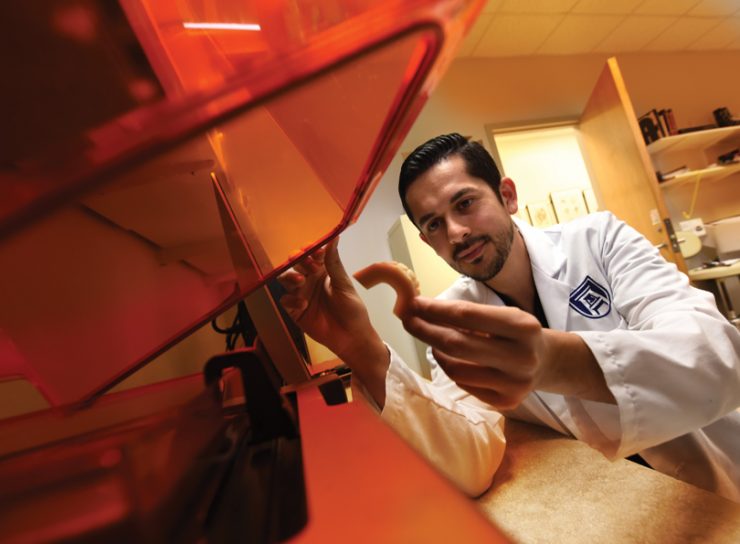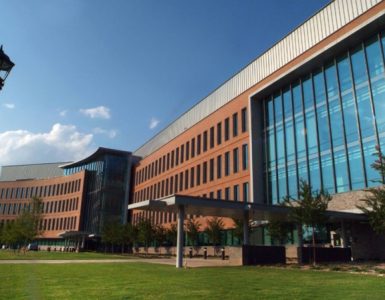3D printing promises to revolutionize dentistry
Dr. Christian Brenes has a guilty pleasure: extreme-makeover shows. “I always wanted to be either a plastic surgeon or a dentist. I watched these shows and realized, ‘Oh, you can do art and science at the same time!’”
Luckily for his patients, Brenes followed that passion.
Brenes, who earned his dental degree in his native Costa Rica and a master’s degree in prosthodontics from the University of North Carolina at Chapel Hill, joined the DCG faculty in 2016 to continue his quest of transforming people’s lives through their smiles.
“I’d been in private practice several years and wanted to devote more time to digital innovations,” says Brenes, assistant professor in the Department of General Dentistry. “I was helping my patients, but I didn’t have the luxury of time to teach and do research. Then my friends (Drs. Roger Arce and Mario Romero, assistant professors in the DCG Departments of Periodontics and Restorative Sciences, respectively) told me, ‘Hey, there’s a really nice position here in Augusta related to what you do.’ I realized this was a great opportunity — going into academics and doing a little bit of everything I enjoy — patient care, research and teaching.”
When Brenes arrived, he was thrilled to find an environment that continually encourages its faculty to push the envelope.
“We’re always embracing cutting-edge technology and on the lookout for the most advanced people in the field to bring their expertise to DCG,” says Dean Carol Lefebvre. “Our college is highly infused with technology, and that is in large part due to the brainpower we attract to our campus.”
Brenes wasted no time making his mark in prosthodontics, which focuses on the design, manufacture and fitting of artificial replacements for teeth and other parts of the mouth. This is the discipline, he noted, that can transform devastating damage — for instance, missing or misshapen teeth caused by factors such as congenital birth defects, trauma or decay — into dazzling and natural-looking smiles.
“The results are absolutely life-changing for some people. Materials, techniques and results are constantly improving,” he says, “and evolving technology is improving the process exponentially.”
“I’ve been fascinated by digital technology throughout my whole career,” Brenes says. “The synergy, efficiency and predictability of it are so exciting.”
Digital innovations sound more like science fiction than science: entering commands into a computer, then having crowns, bridges and other fully customized dental restorations pop out of a three-dimensional printer or a milling machine. Several industries, including space aeronautics, have already fully embraced 3-D technology, and dentistry is catching up fast, Brenes says.
“My passion is treating people who require complex rehabilitations and making a transformation in their lives,” Brenes says, “and this technology is making my job easier than ever.”
Prosthodontists, he says, “are like architects: we make impressions, add wax to models and take the other steps needed to make a design. Now, scanning models and computer software enable milling machines and 3-D printers to create models, prostheses and restorations with high precision using a variety of materials.”
But dental laboratory technicians, he stresses, are still vital. “The diagnostics and artistic portions of the job are things that machines can’t reproduce,” says Brenes. “Dental laboratory technicians will always be the dentists’ right hand. But the technology makes everything so much easier, faster and more predictable.”
Challenges have included perfecting the biocompatible materials used as raw material, as well as creating protocols for integrating software with hardware. And even now, the materials produced by 3-D printers are limited largely to provisional restorations. But a fully digitized process is rapidly evolving.
“As of right now,” Brenes says, “I can scan a model and send it right away to other dental specialists on my team—say, a technician, orthodontist or periodontist—through the internet. The patient is still in the chair while my colleagues are taking a look without having to be physically present. Then, we can use the 3-D technology to prepare provisional restorations in minutes and sometimes mill the final restorations the same day.”
He stresses that the technology is still “in diapers—we take what we know from the analog world and try to duplicate it in the digital world. We’re straddling old-school and new-age techniques—but the technology is getting better all the time.”
Millennials, he says, are eager and willing to master the learning curve. “My students were born with iPads, laptops and iPhones,” Brenes says. “The adoption cycle is much faster for them than for older professionals. I predict that today’s students will be using this technology every single day.”
DCG already houses several milling machines and 3-D printers and is preparing to add more. “Our dental school has been really supportive, and we already have many tools on hand,” Brenes says.
The technology is also increasingly popping up in private practices. “Labs use them the most, due to their productivity levels,” Brenes says. “They see the direct impact of the technology. But we’re increasingly seeing them in dental offices. They’ll be everywhere soon. It’s a very wise decision to invest in digital dentistry when the right time comes.”
The biggest beneficiaries, of course, will be patients. “Digital technology is extremely fascinating,” Brenes says. “And it’s the future.”
3-D Printing at a Glance
• 3-D printing is the next phase in the evolution of computer-assisted design and computer-assisted manufacturing (CAD-CAM) or using software to control machines to manufacture work pieces. Three-D printing describes the additive manufacturing processes that build three-dimensional structures by depositing layers of material on top of each other until the final structure is achieved.
• The cost, ease of use and versatility of 3-D printers have improved greatly over the years. When first introduced to dental labs, 3-D printers were components used in select laboratories only for provisional restorations, but they are now booming not only in dental laboratories but in dental offices. The final product is now the goal. The future: printing teeth from ceramic materials, matching the color and shape of natural teeth.
• It was traditionally challenging to fully integrate digital tools such as 3-D printers into the dental workflow, but that’s changing. The market is catching up with the technology, and offices are increasingly housing state-of-the-art printers and materials.
• Many dental offices and labs are already partially digital (using intraoral scanners, for instance), so the evolution is well underway. For best results, the software must be adjusted and fine-tuned to the particular lab’s/office’s needs. Also, most digital workflows require post-processing (light curing, cleaning, casting, articulation, color correction, etc.), so skilled dental laboratory technicians are still vital.
• New materials are being quickly introduced, including biocompatible materials for areas including digital orthodontics, digital dentures, digital endodontics and oral and maxillofacial surgery.










